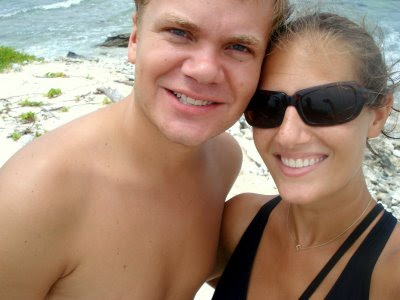There is a chain of islands off the coast of Honduras called Cayos Cochinos. These are unrelated to the Bay Islands (Roatan and Utila), and they are much smaller and also much closer to La Ceiba. In general, we have found that Honduras doesn't have the same caliber of tourism industry as other countries in Central America do, and Cayos was no different. There is no way to fly to any of the Islands, they are only reachable by boat, either from the mainland (ie La Ceiba) or from the Bay Islands.
We rode out to the Islands on a small fishing boat early on Wednesday morning. The seas were rough for such a small boat, we couldn't imagine how the even smaller boats we saw along the beach could make it. We would climb each wave and come down hard and with a spray of salt water in our faces. Soon however we made it to Isla Timon, a 2 palm tree island with a spit of white sand jutting into the "Impossibly" blue water. We snorkeled and found a star fish, N octopus, blue-head wrasse cleaning stations, and little dispersed coral heads. We also played a game of Bocci, final score Chris 2, Kimmy ~2, Jordan 3, Rebecca ~4. No one really keeps track on uninhabited islands.
But then we were hungry, so we got back on the boat went to another tiny island covered with Garifuna homes, restaurants, and pulperias (small convenience stores). We ate fried WHOLE fish, fried plantains, and coconut rice with red beans. Then all the other tourists came, and the tiny beach-side restaurant we were relaxing at turned into a cabana of sunburns, kids, missionaries, and more vendors and their turtle-shell jewelry. When we express our disappointment in seeing turtle-shell earrings, the vendor replies that its, Ok, because these turtles were either very old or by-catch from the fisherman. Both excuses are not really excuses as far as we're concerned.
We spent a long time on the island, we outstayed the other tourists in fact. Probably putting off the ride back to the mainland. But the way back ended being much more physically comfortable and dry... instead it was just terrifying. The captain was very good and surfing down the backside of giant waves. Right before it seemed as though the bow would nose dive into the surf, the captain would turn and we would glide parallel with the wave. We made it home to a falafel, corn on the cob, and chocolate covered grapes pot luck with additional El Sause friends, Stefanie and Jana
















 We just got back from spending the weekend on Utila, one of the other Bay Islands, with Brian and Kurosh. Utila is much more compact and caters more to backpackers than Roatan. The island itself is fairly large, but the only built up part is around a small (maybe 2 mile) cove. It's easy to get from one end of the cove to the other, and on your way you pass street vendors with jewelry, restaurants, bars, and tons of dive shops. The only downfall to this island is the boat ride that takes you to and from Utila. We left in the afternoon and the ride was 1.5 hours of some of the biggest ocean swells ever.
We just got back from spending the weekend on Utila, one of the other Bay Islands, with Brian and Kurosh. Utila is much more compact and caters more to backpackers than Roatan. The island itself is fairly large, but the only built up part is around a small (maybe 2 mile) cove. It's easy to get from one end of the cove to the other, and on your way you pass street vendors with jewelry, restaurants, bars, and tons of dive shops. The only downfall to this island is the boat ride that takes you to and from Utila. We left in the afternoon and the ride was 1.5 hours of some of the biggest ocean swells ever.







